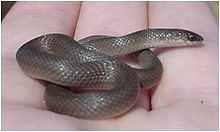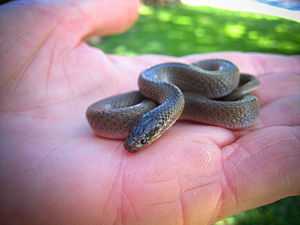Virginia striatula
| rough earth snake | |
|---|---|
 | |
| Scientific classification | |
| Kingdom: | Animalia |
| Phylum: | Chordata |
| Subphylum: | Vertebrata |
| Class: | Reptilia |
| Order: | Squamata |
| Suborder: | Serpentes |
| Family: | Colubridae |
| Subfamily: | Natricinae |
| Genus: | Virginia |
| Species: | V. striatula |
| Binomial name | |
| Virginia striatula (Linnaeus, 1766) | |
| Synonyms | |
|
Coluber striatulus | |
The rough earth snake (Virginia striatula) is a species of nonvenomous natricine colubrid snake native to the southeastern United States. It was first described by Carolus Linnaeus in 1766, as Coluber striatulus.
Geographic range
It is found from Texas to Florida, and as far north as Missouri,Virginia and Arkansas.
Description

Habitat
They are a fossorial species, spending most of their time buried in leaf litter, loose soil, or beneath rotting logs or other ground debris. It prefers habitats that are not prone to flooding.
Reproduction
They are ovoviviparous, with young being born in mid-summer. Brood size varies from 3 to 8. Newborns are about 10 cm (4 inches) in total length.
Behavior
Given their lack of sufficient defense mechanisms against larger animals, earth snakes are generally not aggressive towards humans and are harmless if encountered. While they do have teeth, the size of the mouth and teeth make any strikes against humans superficial at worst. They can defecate as a defense mechanism to make them less palatable to would-be predators. If necessary, they can be safely picked up by hand and relocated.
Diet
Their primary diet consists of earthworms and soft-bodied arthropods. Earth snakes eat a wide variety of suitably sized insects and other invertebrates, including snails and slugs, making them a gardener's friend.
References
- Species Virginia striatula at The Reptile Database
External links
- South Carolina Reptiles and Amphibians: Earth Snake
- Snakes of Georgia and South Carolina: Rough Earth Snake
- Virginia Department of Game & Inland Fisheries: Rough Earth Snake